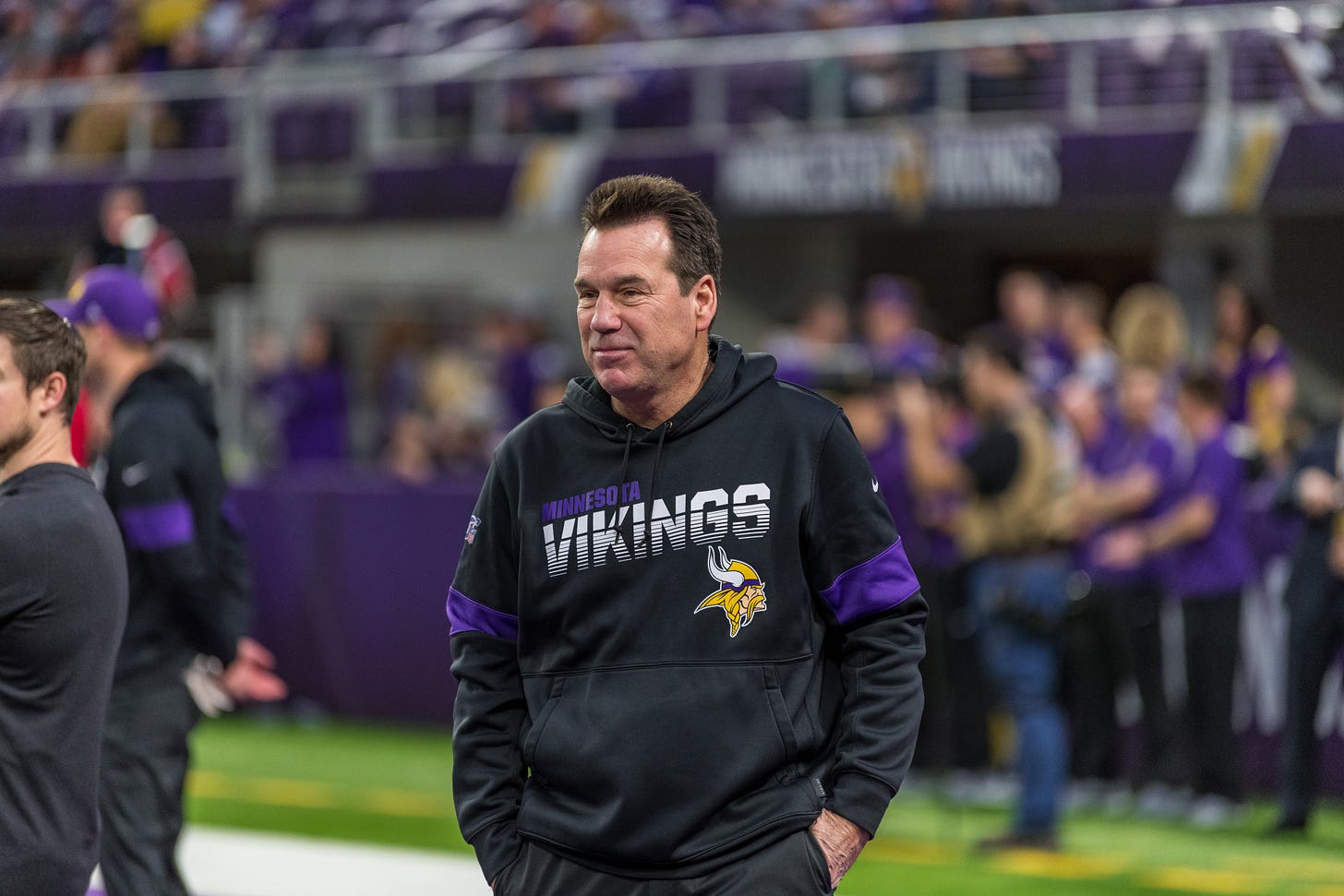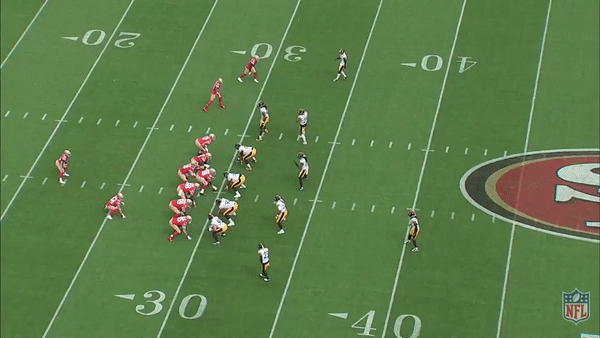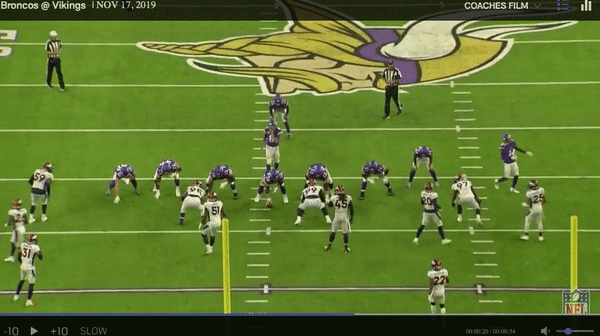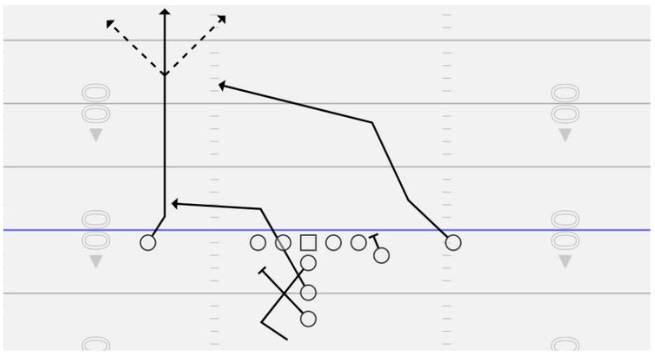How opposing defenses are preparing for the Kubiak offense
Teams are spending the offseason trying to solve the play-action attack

*Photo courtesy of the Minnesota Vikings*
Welcome to Purple Insider: A daily newsletter covering everything Minnesota Vikings by Matthew Coller. With credentialed access combined with a creative and fun approach, my goal is to keep you informed and entertained. Please subscribe if you’d like to read more!
Offensive innovators get all the credit.
When we think back through the history of the NFL there’s always lots of praise to go around those who moved the game in a direction that led to more scoring and every year there are new creations or tweaks to legendary offensives from years past, whether it’s run-and-shoot, Air Coryell, West Coast or spread concepts borrowed from the college game.
Last year we saw the Shanahan/Kubiak style offense, which was spun off Bill Walsh’s West Coast offense of the late-80s, catch fire and produce some of the most explosive teams in the league. Whether it was Kyle Shanahan leading 49ers to the Super Bowl with the highest scoring offense in the NFC or Kirk Cousins setting a career high in QB rating, the Packers going 13-3 or Ryan Tannehill having a furious career comeback, offenses that were built on Shanahan/Kubiak fundamentals made life tough for defenses.
“Football is always really cyclical and for a while there it was the zone read or the Wildcat and all these things and the unbalanced offensive line, and now it’s gone to more misdirection plays with all these guys running across the formation,” Vikings head coach Mike Zimmer said. “I think that’s part of the play-action they’re on. I think there’s a few more teams getting under center now.
But the reason that offensive production has increased at more of a slow burn (the average points scored per game only increased by 4.0 since 1999) rather than in rapid fashion is that the league’s defensive minds have used everything in their power to keep up.
The league’s best defensive minds — including Zimmer — have spent their offseason looking for new ways solve the problems being created by creative additions to a proven scheme.
“You’re probably seeing more trends defensively, the way teams are attacking some of this stuff,” Zimmer said.
So how will the Vikings combat the increase of Shanahan/Kubiak influences and how will opposing defenses plot against the Vikings’ long-successful offensive coordinator?
Let’s have a look…
What’s making life hard on defenses
Any time someone talks about the Shanahan or Kubiak offense, the first thing you will hear is, “marrying the run with the pass.”
For defenses, stopping the run requires gaps to be filled, which opens the door for the offense to know exactly where defensive players will go if they can make a passing play look like a run. Former NFL quarterback Steve Beuerlein, who played for Kubiak in Denver, explained:
“Whether it’s the safety coming down too early in run support, whether it’s the linebackers flowing too hard on the stretch zone play, whether it’s the backside defensive end crashing down trying to run that play down from behind, Gary has an answer,” Beuerlein said.
The more ways in which the offense add confusion to the mix, the more they can slow down the defense’s ability to recover after realizing that the offense is passing instead of running. Shanahan takes it, as Homer Simpson might say, to the extreme.
Here’s an example of misdirection from the 49ers that includes a pre-snap motion, a fake reverse, a play-action, the offensive line zone blocking and the fullback going from strong to weak side to block. Only two receivers go out for patterns but Pittsburgh’s box defenders all jump up to fill gaps and leave George Kittle running wide open.

You might remember such concepts being applied to Kirk Cousins touchdowns from Stefon Diggs’s Philadelphia game, the opening drive against Detroit and the 20-point comeback against Denver.

Add the misdirection with bigger personnel groupings that include multiple tight ends or fullbacks that force opponents to either match the size-strength with extra linebackers or get run over with lighter defensive backs and you have a nearly impossible task for defenses. In the NFC Championship game the Packers committed to stopping the play-action pass and got trucked by the 49ers’ running game in historic fashion.
There are answers though — some of which Zimmer has already found and some that the Vikings’ offense will see more and more going forward.
How defenses can slow it down
Let’s break it down by levels.
The teams that gave the Vikings the toughest matchups last year were those that had deep and dominant defensive lines. Kenny Clark and Za’Darius Smith toyed with the Vikings in Weeks 2 and 16, Eddie Goldman and Khalil Mack demolished the Vikings’ O-line in Week 4 and Chris Jones put on a vulgar display of power in Minnesota’s loss to Kansas City.
Shutting down a Shanahan/Kubiak offense starts with personnel.
“The only place in the NFL where the defense is better than the offense on a consistent level is the defensive line,” said Cody Alexander, currently the co-defensive coordinator/safeties at Mesquite Horn High School and an author of numerous defensive strategy books.
“You can manipulate a linebacker, you can throw away from a secondary player but it is hard to start doubling an anchor point [on the defensive line] where you are trying to run away from somebody,” Alexander said. “You've now eliminated a huge part of your offense.”
There’s a domino effect of having a monster defensive line that impacts another level of the defense: The safeties.
On a given play you will see either two safeties playing deep or one deep with the other playing up toward the line of scrimmage with the linebackers. If a D-line is dominant enough to slow down the run themselves — like, say, with Linval Joseph eating up two offensive linemen — then the defense doesn’t always need to add an extra safety to the box.
Pro Football Focus’s Seth Galina studied one-high versus two-high. Often teams will switch to a run play on first down against two-high, thinking that they have the advantage. But in reality with a beastly D-line, the offense isn’t getting ahead. He wrote:
“By playing more two-high, you can ‘steal a down’ by giving the offense a look it wants to run against but still get a stop.”
Motions are also more difficult to stop with a single safety playing deep.
“You get into problems with [motion] in a single high because no everybody has to rotate over,” Alexander said. “In two-high and the quick motion is coming, I can drop down the safety and he's working through the slant window so the RPO off of it.”
One of the things that wrecks havoc on safeties in the Kubiak offense is deep crossing routes. Even with two deep, the receivers adjust routes to the safety’s decision and routes on the opposite side are designed to draw his attention.

*Graphic from this article explaining deep crossers by Bobby Peters
“I think what you're going to have to do is change some of the rules within coverages to layer and find ways to get different layers within the middle of the field even when you are a [two deep safety] team,” Alexander said.
Changing the rules means (which simply means altering assignments) might start with linebackers, who have been trained their entire careers to plug gaps and stop the run first. But the NFL has increased play-action usage to draw them in. Per PFF, there were 20 quarterbacks who used play-action on at least 25% of drop backs. In 2014 there were just eight who had play-action on one-fourth of passes.
“You're going to have to start playing it like you're going to divorce the front and the back end more than they normally have,” Alexander said. “Everything [on offense] is going to have some sort of play-action or RPO or they're going to run routes to keep you honest [on run plays]. You can't really tell if the quarterback is supposed to hand it off or read it.
We have already seen a change in the shape of LBs. When Eric Kendricks was drafted by the Vikings he was considered undersized at 232 pounds. At this year’s Combine there were 25 linebackers under 240 pounds.
“I think you're seeing the trickle-up to where the offenses have figured out how to get these [middle] linebackers into space,” Alexander said. “He can't just be a plugger...I think the next evolution is that we have to have those hybrid linebackers.”
The Vikings’ draft pointed exactly in the direction of hybrid players, whether it was undersized linebacker Troy Dye, a coverage specialist out of Oregon, or versatile safety Josh Metellus from Michigan.
They have also benefitted from Kendricks and Anthony Barr’s unique ability to recover and to challenge running backs out of the backfield. Not every team will be able to replicate that level of talent.
In fact, you can see how why the Vikings have been successful on defense in many instances against the Shanahan style offense. They’ve had dominant defensive linemen who can allow Zimmer to play two deep safeties, linebackers who can cover and a hybrid player in Harrison Smith who can impact all three levels.
While building a defense that deep is difficult, you may see the league steal some of Zimmer’s ideas when it comes to stopping the Shanahan offense, including his way of dealing with motions. The cornerbacks do not run with the motioning receiver.
“That helps you in a couple ways,” Alexander explained. “Everything is funneled to the middle of the field to your two safeties and the other part is with… all that quick motion, you have a guy who's fast just sitting on the other side. A lot of times when San Francisco would run that orbit motion behind the back and fake that reverse, well there's a corner sitting on the other side.”
That’s just one strategy. There’s so many it would make your head spin. Having linebackers carry certain routes, giving blitz looks and dropping back or attacking with nickel blitzes to the possible play-action side with the hope of a drive-altering big play.
Check out Cody Alexander’s breakdown of the Vikings and 49ers’ defensive approaches in the divisional playoff game….
It’s a smart player’s league. Stopping an offense that’s designed to have an answer to everything requires players to have a encyclopedic knowledge of their defense and be able to adjust on the fly. Throughout his time in Minnesota Zimmer has consistently chosen smarts over other skills when it comes to assigning roles.
The 2020 outlook
Is every defense in the league suddenly going to stack up with a defensive line as good as the 49ers that features hybrid players and a scheme with two deep safeties and linebackers with adjusted assignments specifically designed to slow down play-action success? Of course not. But every step they take toward those things matters.
So where can the Vikings make up the difference? If opponents are going to focus on the play-action more, they will need a healthy Dalvin Cook to make them pay. The offensive line must perform better than the 10th highest pressure rate (despite all of Kubiak’s efforts to help Cousins). More players will have to step into the limelight a la Irv Smith, Justin Jefferson, Bisi Johnson and Co.
Where the Vikings have a distinct advantage is that Kubiak has seen this before. Defenses have been trying to invent rules to stop his offense since the 90s and haven’t yet succeeded. Keeping the offensive scheme the same for two years in a row, finally, gives them a chance to make those alterations in a strange offseason atmosphere.
And history has always leaned toward offense, even if defenses have slowed down its progress.
Check out our new sponsor SotaStick and their Minnesota-inspired gear by clicking the logo. Use the code PurpleInsider for free shipping.


Very interesting, especially with the change in LB's. And one can already see how teams are evolving to take advantage of these faster, lighter LB's with a power running attack. The Titans and 49'ers are the most obvious examples currently but I expect this trend to continue. Given the comments by Matt La Fleur in the off season and GB's rather...unusual draft, it appears that they're gearing up to become more of a power running team as well. What's old is new again.
“Football”